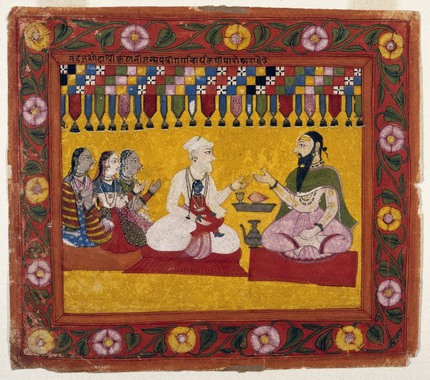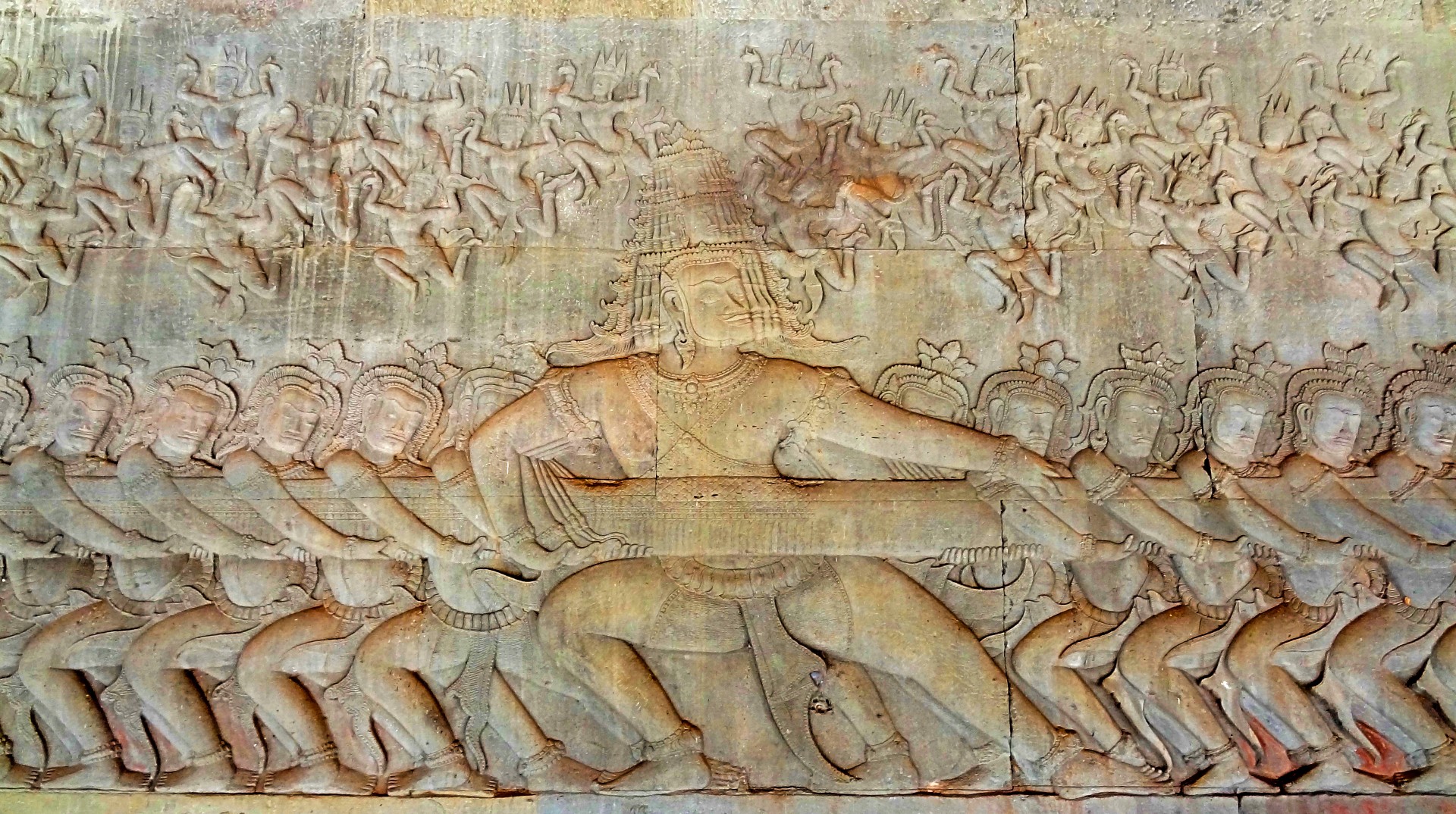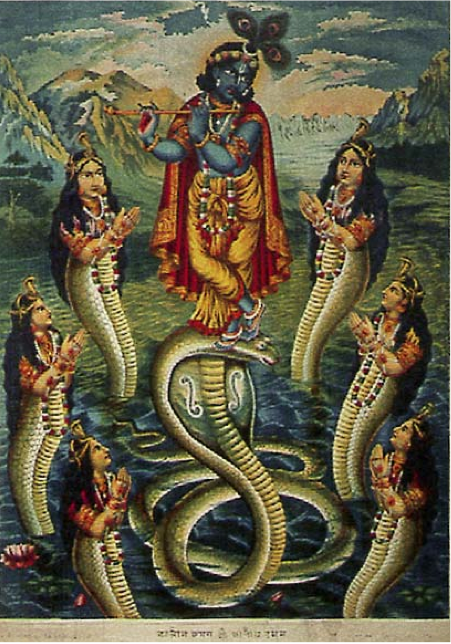|
Trinavarta
Trinavarta (, IAST: ) is an asura who is featured in Hindu literature, most prominently in the Bhagavata Purana. He is described to be a whirl-wind asura dispatched by Kamsa to murder Krishna, but is slain by the deity instead. Legend Kamsa sent Trinavarta to kill his nephew. Assuming the form of a whirl-wind, Trinavarta carried away the sitting Krishna. He enveloped the whole of Gokulam with a cloud of dust and darkness, the resultant cover of sand particles causing great distress to Yashoda, who attempted to find her son with the help of the gopis. Even as the asura carried the deity to the sky, Krishna caused himself to possess enormous weight, halting the asura in his ascent, who was unable to carry him farther. The deity then proceeded to clasp his captor's throat with intense force, which paralysed him and pushed out his eye-sockets. The asura descended back to the region of Vraja, where he was crushed to death upon a rock. Nanda and the gopas discovered the infant dangl ... [...More Info...] [...Related Items...] OR: [Wikipedia] [Google] [Baidu] |
Rukminisha Vijaya
Rukminisha Vijaya (, ), is a Vaishnava work composed by the 16th-century Hindu, Madhava saint, Vadiraja Tirtha. It is an important work of Sanskrit literature, containing 19 chapters and 1,241 verses in various metres. The text is written in the Vaidarbhi style. Rukminisha Vijaya is a mahakavya, rendered in the kāvya style, narrating the life of Krishna from boyhood, and ending with his marriage with Rukmini, his chief consort. The book highlights the story of Krishna, as described in the 10th canto of the Bhagavata Purana. Analysis The Rukminisha Vijaya is noted as an exemplar of Dvaita philosophy, and its opposition of the Advaita doctrine. It describes the exploits of Krishna, whose "unquestioned supremacy" is represented by the saint Vadiraja. Quoting on the style of the work, Indologist B. N. Krishnamurti Sharma writes, "The descriptions are effective and natural. The style is deeply alliterative. Sense and sound match well and the imagery is fine and lofty". Conten ... [...More Info...] [...Related Items...] OR: [Wikipedia] [Google] [Baidu] |
Aghasura
Aghasura ( Sanskrit: अघासुर) is an asura featured in Hindu literature, most notably in the Bhagavata Purana. He was one of Kamsa's generals, and the elder brother of the demoness Putana and Bakasura. Agha is stated to be as one of the tribes that was in alliance with Kamsa. The killing of Aghasura by Krishna is narrated by the sage Shuka to King Parikshit in the Bhagavata Purana. Legend King Kamsa made many attempts on the life of Krishna, all of them failing. Then he sent Aghasura to kill Krishna, who did so willingly knowing that his younger siblings Putana and Bakasura were killed by Krishna. He assumed the form of the 8-mile-long serpent, disguising his open mouth against a mountain. All the cowherd boys entered the mouth of the demon, mistaking it to be a cavern. When the serpent closed his mouth, the victims generally suffocated to death. Krishna entered the serpent upon his arrival and then increased the size of his own body. In response, the demon to ... [...More Info...] [...Related Items...] OR: [Wikipedia] [Google] [Baidu] |
Krishna Kills The Tornado Demon Trinavarta, Folio From The 'Tularam' Bhagavata Purana (Ancient Stories Of The Lord) LACMA M
Krishna (; sa, कृष्ण ) is a major deity in Hinduism. He is worshipped as the eighth avatar of Vishnu and also as the Supreme god in his own right. He is the god of protection, compassion, tenderness, and love; and is one of the most popular and widely revered among Indian divinities. Krishna's birthday is celebrated every year by Hindus on Krishna Janmashtami according to the lunisolar Hindu calendar, which falls in late August or early September of the Gregorian calendar. The anecdotes and narratives of Krishna's life are generally titled as ''Krishna Leela''. He is a central character in the ''Mahabharata'', the ''Bhagavata Purana'', the ''Brahma Vaivarta Purana,'' and the ''Bhagavad Gita'', and is mentioned in many Hindu philosophical, theological, and mythological texts. They portray him in various perspectives: as a god-child, a prankster, a model lover, a divine hero, and the universal supreme being. Quote: "Krsna's various appearances as a divine her ... [...More Info...] [...Related Items...] OR: [Wikipedia] [Google] [Baidu] |
Nanda (Hinduism)
Nanda () is a cow-herd chief, and the foster-father of Krishna, featured in the Harivamsha and the Puranas. Nanda is the son of Parjanya, a ruler of the Vraja region, who is a son of the Yadava king, Devamida. He is the chief of Gokulam, which is one of the most powerful territories of the Yadava tribe. He is sometimes referred to as a king. Nanda is the cousin of Vasudeva. Vasudeva takes his newborn son, Krishna, to Nanda on the night of the child's birth, so that Nanda could raise him. The chief, who is married to Yashoda, brings up both Krishna, and his brother, Balarama. Krishna derives his epithet ''Nandanandana'' (son of Nanda) from him. Legend Nanda was the foster-father of Krishna. He also helped to raise Balarama. Nanda, identified as King Nanda in many scriptures was a kinsman and a great friend of Vasudeva. The fact that King Nanda and King Vasudeva were cousins is confirmed both by the Bhagavata Purana, Book 10, and the Mahabharata. King Vasudeva married Devaki, ... [...More Info...] [...Related Items...] OR: [Wikipedia] [Google] [Baidu] |
Asura
Asuras (Sanskrit: असुर) are a class of beings in Indic religions. They are described as power-seeking clans related to the more benevolent Devas (also known as Suras) in Hinduism. In its Buddhist context, the word is sometimes translated "titan", "demigod", or "antigod". According to Hindu scriptures, the asuras are in constant battle with the devas. Asuras are described in Indian texts as powerful superhuman demigods with good or bad qualities. In early Vedic literature, the good Asuras are called ''Adityas'' and are led by Varuna, while the malevolent ones are called ''Danavas'' and are led by Vritra. In the earliest layer of Vedic texts Agni, Indra and other gods are also called Asuras, in the sense of their being "lords" of their respective domains, knowledge and abilities. In later Vedic and post-Vedic texts, the benevolent gods are called ''Devas'', while malevolent Asuras compete against these Devas and are considered "enemy of t ... [...More Info...] [...Related Items...] OR: [Wikipedia] [Google] [Baidu] |
Kaliya
Kaliya ( IAST: Kāliya, Devanagari: कालिय), in Hindu traditions, was a venomous Nāga living in the Yamunā river, in Vṛndāvana. The water of the Yamunā for four leagues all around him boiled and bubbled with poison. No bird or beast could go near, and only one solitary Kadamba tree grew on the river bank. The celebration of Nāga Nathaiyā or Nāga Nṛitya is associated with the tale of Lord Krishna dancing upon and subduing Kāliya. Story The story of Krishna and Kāliya is told in the sixteenth chapter of the Tenth Canto of the ''Bhagavata Purana''. The proper home of Kāliya was the island of Ramaṇaka, but he had been driven away from there in fear of Garuḍa, the foe of all serpents. Garuḍa had been cursed by the yogi Saubhari dwelling at Vrindavan so that he could not come to Vrindavan without meeting his death. Therefore, Kāliya chose Vrindavan as his residence, knowing it was the only place where Garuḍa could not come. Once, the sage Du ... [...More Info...] [...Related Items...] OR: [Wikipedia] [Google] [Baidu] |
Vyomasura
Vyomasura (, IAST: Vyomāsura) is an asura who appears in Hindu literature. He is a son of Mayasura. His death at the hands of the deity Krishna is described in the Bhagavata Purana. Legend Following the slaying of the horse-demon Keshi by Krishna and Narada's salutation of him, the deity tended the cattle along a mountain slope along with the ''gopas'', the cow-herding youth. They decided to play a game similar to hide-and-seek, where there divided themselves into the roles of three groups: the cattle, the cattle-keepers, who had to protect the cattle, and the cattle-lifters, who had to attempt to steal the animals. Vyoma, a magically-gifted asura who was the son of Mayasura, disguised himself as a youth, and played the part of a cattle-lifter, stealing away a number of the boys who posed as goats and other creatures. He carried each of them to the mountain caves and shut the boys within them, until only half a dozen boys had not been captured. Realising that his friends ha ... [...More Info...] [...Related Items...] OR: [Wikipedia] [Google] [Baidu] |
Durvasa
In Hindu scriptures, Durvasa ( sa, दुर्वासा, ) also known as Durvasas (Sanskrit: दुर्वासस्), is a legendary rishi (sage). He is the son of Anasuya and Atri. According to some Puranas, Durvasa is a partial avatar of Shiva, known for his short temper. Wherever he goes, he is received with great reverence by humans and devas alike. Curses and boons The rishi Durvasa, being short-tempered, is said to have both cursed and gifted boons to several notable deities and people in the Hindu scriptures. Some of them include: Curses # Indra, whom he cursed to lose all his powers, after Indra's elephant Airavata threw down a rather fragrant garland given by Durvasa to Indra. # Saraswati, whom he cursed to be born as a human because she laughed at his incorrect recitation of the Vedas. # Rukmini, whom he cursed to be separated from her husband, Krishna, because she drank water without seeking Durvasa's permission. # Shakuntala, who avoided Durvasa while ... [...More Info...] [...Related Items...] OR: [Wikipedia] [Google] [Baidu] |
Brahma Vaivarta Purana
The ''Brahmavaivarta Purana'' ( sa, ब्रह्मवैवर्त पुराण; ) is a voluminous Sanskrit text and a major Purana (''Maha-purana'') of Hinduism. It is an important Vaishnavism text. This Purana majorly centers around the Hindu deities Radha and Krishna. Although a version may have existed in late 1st millennium CE, its extant version was likely composed in the Bengal region of Indian subcontinent. Later, it was likely revised somewhere in South India. Numerous versions of this Purana exist and are claimed to be the part of manuscripts of the ''Brahmavaivarta Purana'' or the ''Brahmakaivarta Purana''. The text is notable for identifying Krishna as the supreme reality and asserting that all gods such as Vishnu, Shiva, Brahma, Ganesha are one and the same and in fact, all are the incarnations of Krishna. Goddesses like Radha, Durga, Lakshmi, Saraswati and Savitri are asserted to be equivalent and are mentioned as the incarnations of Prakruti in this ... [...More Info...] [...Related Items...] OR: [Wikipedia] [Google] [Baidu] |
Braj
Braj, also known as Vraj, Vraja, Brij or Brijbhoomi, is a region in India on both sides of the Yamuna river with its centre at Mathura- Vrindavan in Uttar Pradesh state encompassing the area which also includes Palwal and Ballabhgarh in Haryana state, Bharatpur district in Rajasthan state and Morena District in Madhya Pradesh.Janet Cochrane, 2008Asian Tourism: Growth and Change page 249. Within Uttar Pradesh it is very well demarcated culturally, the area stretches from the Mathura, Aligarh, Agra, Hathras and districts up to the Farrukhabad, Mainpuri and Etah districts. Braj region is associated with Radha and Krishna who according to scriptures were born in Barsana and Mathura respectively. It is the main centre of Krishna circuit of Hindu pilgrimage. It is located 150 km south of Delhi and 50 km northwest of Agra. Etymology The term Braj is derived from the Sanskrit word ''vraja (व्रज)''. Vraja was first mentioned in Rigveda, and in Sanskrit it ... [...More Info...] [...Related Items...] OR: [Wikipedia] [Google] [Baidu] |
International Alphabet Of Sanskrit Transliteration
The International Alphabet of Sanskrit Transliteration (IAST) is a transliteration scheme that allows the lossless romanisation of Indic scripts as employed by Sanskrit and related Indic languages. It is based on a scheme that emerged during the nineteenth century from suggestions by Charles Trevelyan, William Jones, Monier Monier-Williams and other scholars, and formalised by the Transliteration Committee of the Geneva Oriental Congress, in September 1894. IAST makes it possible for the reader to read the Indic text unambiguously, exactly as if it were in the original Indic script. It is this faithfulness to the original scripts that accounts for its continuing popularity amongst scholars. Usage Scholars commonly use IAST in publications that cite textual material in Sanskrit, Pāḷi and other classical Indian languages. IAST is also used for major e-text repositories such as SARIT, Muktabodha, GRETIL, and sanskritdocuments.org. The IAST scheme represents more than ... [...More Info...] [...Related Items...] OR: [Wikipedia] [Google] [Baidu] |







